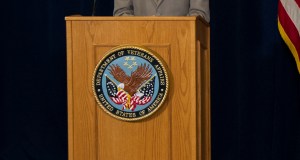VA’s AI Tech Sprint yields a tool for matching patients with clinical trials, and more

A group of high school students was one of the top teams to emerge from the recent AI Tech Sprint by the Department of Veterans Affairs, delivering a web application that could help match cancer patients to clinical trials.
The three students from Northern Virginia entered their work in a competition that included software companies like Oracle Healthcare and MyCancerDB. Digital consulting company Composite App took the $20,000 first place prize for its solution — a tool for helping patients stay on track with their care plan — but the clinical trials team got an honorable mention.
The tech sprint was organized by the VA’s new AI institute, and it focused on partnering with outside organizations and companies interested in applying artificial intelligence tools and techniques to VA data.
The high school team’s members — Shreeja Kikkisetti, Ethan Ocasio and Neeyanth Kopparapu — met as part of the Northern Virginia-based nonprofit Girls Computing League. They were unique in a competition otherwise dominated by adult professionals from software and health care companies.
Their solution, the Clinical Trials Selector, takes lab results, diagnosis and demographic data from the VA and Centers for Medicare and Medicaid Services (CMS) and uses natural language processing as part of its technology to match patients to trials from the National Cancer Institute’s clinical trials database.
The current process for matching patients to trials is a bit more laborious for both the patients themselves and for doctors, Gil Alterovitz, the VA’s director of AI, told FedScoop. It can involve veterans inputting their own data into the clinical trials database — a process that can be confusing and time-consuming.
The Clinical Trials team’s solution, on the other hand, envisions a world where veterans don’t need to have an in-depth understanding of their own medical charts — instead they can log into their personalized VA.gov portal and automatically be matched to potential trials. The application is “functional,” team member Ethan Ocasio told FedScoop, but the team is still working to move it out of a sandbox and make it “production ready” for the VA environment.
Shreeja Kikkisetti and Ocasio told FedScoop that the biggest challenge of the sprint was learning to work with medical informatics. But they both said being a part of the sprint was a “fantastic opportunity” to put their coding skills to a real world test. Ultimately, both said they envision the application being an open source framework available for use by a variety of institutions, not just the VA.
Other companies involved in the sprint include Sanford Imagenetics, which created a product for determining of the relevance of pharmacogenetic testing based on patient characteristics, and LifeOmic, which built a visualization tool for the data sharing platform known as the Veterans Precision Oncology Data Commons.
The VA has become increasingly interested in positioning itself as a federal leader in artificial intelligence research and development. The agency has also recently launched AI projects like an effort to use AI to reduce veterans’ wait times for health appointments, and another to scan medical records and evaluate suicide risk as part of the REACH VET program.



